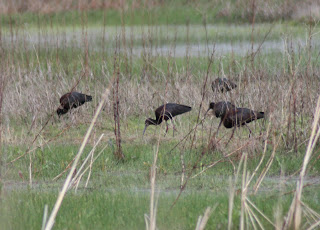Probably one of the first birds everyone is able to identify, one of the most abundant birds across North America, and one of the most boldly colored, JULY'S BIRD OF THE MONTH the Red-winged Blackbird is a familiar sight atop cattails, along soggy roadsides, wetlands, and power lines.
Year round residents of northern Utah, glossy-black males have scarlet-and-yellow shoulder patches they can puff up or hide depending on how confident they feel. Females are a subdued, streaky brown, almost like a large, female House Finch. When they start their familiar call in early March is a happy indication of the return of spring.
Male Red-winged Blackbirds fiercely defend their territories during the breeding season, spending more than a quarter of daylight hours in territory defense. He chases other males out of the territory and attacks nest predators, sometimes going after much larger animals, including horses and people.
Red-winged Blackbirds roost in flocks in all months of the year. In summer small numbers roost in the wetlands where they breed. Winter flocks can be congregations of several million birds, including Brewers Blackbirds and starlings. Each morning the roosts spread out, traveling as far as 50 miles to feed, then re-forming at night.
Red-winged Blackbirds spend the breeding season in wet places like fresh or saltwater marshes. You may also find them breeding in drier places like sedge meadows, alfalfa fields, and fallow fields. Occasionally, Red-winged Blackbirds nest in wooded areas along waterways. In fall and winter, they congregate in agricultural fields, feedlots, pastures, and grassland.
Red-winged Blackbirds eat mainly insects in the summer and seeds, including corn and wheat, in the winter. Sometimes they feed by probing at the bases of aquatic plants with their slender bills, prying them open to get at insects hidden inside. In fall and winter they eat weedy seeds such as ragweed and cocklebur as well as native sunflowers and waste grains
























































